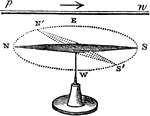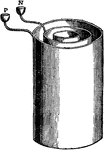Clipart tagged: ‘galvanic’

Galvanic Battery
"Galvanism is the branch of electric science to which an experiment by Galvani gave birth. His wife,…

Galvanic Battery
"If we take for example, a slip of zinc, and another of copper, and place the in a cup of diluted sulphuric…

Electrical Helix
"A copper wire coiled, by winding it around a piece of wood. The turns of the wire should be close together…

Magnetic Telegraph
"Morse magnetic telegraph will be understood by reference to the accompanying diagram, which represents…

Uniting Wire above the Needle
"The instant this is done and the galvanic circle completed, the needle will deviate from its north…
